JOIN THE ‘BEST BOOK CLUB’ NOW HERE
DOWNLOAD THIS FREE PDF SUMMARY HERE
STOP TRYING TO ACHIEVE YOUR GOALS BY YOURSELF AND BE COACHED TODAY HERE
CHECK OUT THE FOLLOWING Book | Summaries | Course | YouTube |Spotify | Instagram | Facebook | Newsletter | Website
Great by Choice: Uncertainty, Chaos, and Luck–Why Some Thrive Despite Them All
by Jim Collins
BOOK SUMMARY
THRIVING IN UNCERTAINTY
“The future cannot be exactly foretold, but we can create it.”
With these optimistic words, Collins and Hansen enumerate the problems that have arisen for all businesses in the 21st-century, and the years leading up to then. Despite these problems, some companies have overachieved. He gives them the moniker 10X, which means that the company beat its industry index by a minimum of 10 times. They and their research team poured over the records of more than 20,000 companies to reach the book’s conclusions.
Among these were Amgen, Biomet, Intel, Microsoft, Progressive Insurance, Southwest Airlines, and Stryker. The study began in 2002 and covers the decades before then, depending on the company. As an example, Microsoft is compared with Apple. During the 80s and 90s, Microsoft won hands-down against Apple, however since then Apple, under inspired leadership, has gone from strength to strength, while to some, Microsoft seems to be floundering.
Five entrenched myths are examined and found to be inaccurate. One of these myths is that radical change on the outside requires radical change on the inside. In fact, 10X companies changed less intentionally than the comparisons.
10Xers
The authors discuss the 10X companies and their leaders and compare them with the Antarctic adventures of the two great explorers, Amundsen and Scott, in the race to be the first to reach the South Pole. The main reasons that Amundsen won were meticulous preparation going back many years and his careful consideration of what he was doing.
The authors’ findings of 10X companies are fascinating and show that these companies are not more creative, visionary, charismatic, ambitious, blessed by luck, risk-seeking, heroic or prone to making big, bold moves. So why do 10X companies do so well? They realize that they are in unpredictable circumstances but refuse to abdicate responsibility for what happens. They take full responsibility and when they do this they demonstrate fanatic discipline, empirical creativity, and productive paranoia.
Each of these three is discussed, fanatic discipline is considered first. They see Peter Lewis of Progressive Insurance, as exemplifying fanatic discipline in his actions in that company. The authors call discipline consistency of action, which in its highest form, is self-discipline. The authors say that this discipline is typical of 10X companies and can be described as monomaniacal.
Another executive showing fanatic discipline was Herb Kelleher of Southwest Airlines, who took an interest in all parts of the business while being strangely dressed to animate the culture of his airline, an animation that he saw as vital to the business of the airline.
Empirical creativity-what is this? It is creativity tempered by reality and facts rather than whim and untested theories. Andy Grove, CEO of Intel, in overcoming prostate cancer, while fulfilling his role as CEO was shown as one of the best examples of empirical creativity.
What about productive paranoia? This means a never-ending and very careful assessment of risk. The book discusses Bill Gates and Microsoft in its consideration of this. It contrasted the fears and concerns, which governed the actions of Bill Gates in comparison to the overly optimistic behavior of John Scully, the CEO of Apple during the 90s.In considering the risks, the 10X leaders mentally ready themselves for disaster, while less paranoid leaders are oblivious to it, as they do not even consider it.
JOIN THE ‘BEST BOOK CLUB’ NOW HERE
DOWNLOAD THIS FREE PDF SUMMARY HERE
STOP TRYING TO ACHIEVE YOUR GOALS BY YOURSELF AND BE COACHED TODAY HERE
CHECK OUT THE FOLLOWING Book | Summaries | Course | YouTube |Spotify | Instagram | Facebook | Newsletter | Website
CEO’s of 10X Companies
The chapter concludes by looking for characteristics of the CEOs of 10X companies. Large pay is not a feature, some such as Dane Miller off Biomet were almost underpaid. The desire to be the center of attention was not a necessary feature. Gordon Moore, CEO of Intel for about a decade was the keeper of a very low profile. A feature that all CEOs of 10X companies have is a great dedication to the company.
That being the case, there is no uniformity in the background of CEOs of 10X companies. Some have come from very deprived backgrounds, some from ordinary middle-class backgrounds, while still others from backgrounds, which are very privileged.
20 MILE MARCH
This chapter is entitled the 20-mile march and deals with the importance of consistency, rather than a mixture of great jumps upward and steep falls downward, in performing well over a long time period. Research about the 20-mile march indicates that it is a distinguishing factor, to an overwhelming degree, between 10X companies and comparison companies.
In order to march 20 miles successfully, you need to hit specified markers with great consistency over a very long period of time.
In a good 20-mile march, good performances are achieved during times that are difficult and there is sensible non-overly ambitious advance when times are good. A good 20-mile march has the following seven features:
- Clear performance markers
- Self-imposed constraints
- A 20-mile march that is applicable to the specific enterprise
- The 20-mile march must be within the company’s ability to reach
- A proper timeframe that is long enough to manage, yet enough to have teeth
- Imposed by the company upon its self
- Achieved with high consistency
A 20-mile march may not have to be financial. 20-mile marches are very useful in every sphere of human endeavor. It is possible to have creative marches, learning matches, service improvement marches or any other type of activity, as long as it has the characteristics of a good 20-mile march.
BULLETS AND CANNONBALLS
The authors use the parable of a small ship in a war being menaced by a large enemy vessel. If all ammunition on the small ship is made into one large cannonball, but it misses when it is fired, then all is lost. However, a sequence of bullets will allow the gunners to practice until they know exactly how to hit the larger ship. Then and only then, all remaining ammunition is used to make a cannonball, which when it hits the larger ship will win the battle.
A number of cases, involving 10X companies, where Fire Bullets then Cannonballs approaches were used to illustrate the concept brilliantly in a business context. The last example is that of Apple and Steve Jobs, who used the iPod as first a bullet then a cannonball to move Apple on its amazing rebirth in the first decade of this century.
Here are some important points about the idea of firing bullets first then cannonballs.
- The fire bullets then cannonballs approach is a good explanation for the success of 10X companies, in comparison to others who depend on great leaps, which often fail.
- A bullet has little cost or risk and is a very good test for what will work, which then becomes a cannonball and has high cost and risk but promises good returns.
- Cannonballs must be calibrated. There must be very good empirical evidence to justify a cannonball. If that evidence is lacking the cannonball is uncalibrated and has a high probability of being disastrous.
- 10X companies sometimes fire uncalibrated cannonballs, but they quickly self-correct, rather than throwing good money after bad, which comparison companies are prone to do.
- A cannonball, once calibrated, should be fired. Failure to do so is the path to mediocrity. Acquisitions are often bullets.
Some innovation is good and necessary, but 10X companies are the main innovators in any particular industry.
JOIN THE ‘BEST BOOK CLUB’ NOW HERE
DOWNLOAD THIS FREE PDF SUMMARY HERE
STOP TRYING TO ACHIEVE YOUR GOALS BY YOURSELF AND BE COACHED TODAY HERE
CHECK OUT THE FOLLOWING Book | Summaries | Course | YouTube |Spotify | Instagram | Facebook | Newsletter | Website
LEADING ABOVE THE DEATH LINE
This chapter is a eulogy to the importance of productive paranoia and being well prepared. Doing your homework. Doing due diligence. The death line is a series of criteria, which if a company reaches means that they are usually finished. Productive paranoia is put into three categories. Paranoia 1-Build Cash Reserves and Buffers; a conservative approach to money and resources among 10X companies is noted. Cash reserves are very important when there is a black swan event. A black swan event is one that has a low probability of occurring but can have devastating consequences.
Productive paranoia 2- Bounding risk; risks are put in three groups. As previously mentioned death line risks are those that could bring a company to its knees figuratively. Asymmetric risks are those where the potential downside is far greater than the possible return. Uncontrollable risks are precisely that and are risks that are outside of the ability of companies to control. Productive paranoia 3-Zoom out Zoom in; zoom out means constantly assessing the conditions then having seen what they are zoom in, which means take action.
- 10X companies realize that not all future events can be reliably predicted, so they get ready and take precautions for what might lie ahead. Acting in this way means the company can proceed in times of adversity and difficulty.
- 10X companies take a very conservative approach to risk.
- 10X companies take on far fewer risks than comparison companies.
- 10X companies are rarely in a rush.
SMaC
SMaC stands for specific, methodical and consistent, as applied to a set of rules. What is called a SMaC recipe is a set of robust operating practices, often enduring for decades in 10X companies. SMaC recipes are only changed by 10X companies partially and only when there is strong empirical evidence that change is essential. Non-10X companies have SMaC recipes that have frequently and massively changed. Change should occur not only when there is strong empirical evidence for it but also after a lot of bullet firing.
The chapter is full of interesting anecdotes, a number taken from the computing industry. Intel has long had SMaC recipes and has only changed one of the edicts so that they got out of manufacturing micro-processers. Microsoft was completely devoted to the standalone computer, until 1994, when the importance of the Internet became obvious. At this time, the Internet was incorporated into Microsoft’s SMaC recipes. Apple massively declined, until Steve Jobs returned. When he did, he resurrected the SMaC recipes that Apple used when he was previously in charge there.
The book draws the important comparison between a SMaC recipe and the constitution of a country. It must not be overly restrictive and constraining, but also not so loose that it can be frequently and massively changed.
LUCK
To most people, good luck means good fortune coming by chance and conversely, bad luck means bad fortune also coming by chance. In this chapter, a possible definition is given of what the book calls a luck event. It has to have three features:
- The event is independent of the person receiving it
- The event is important
- The event is unpredictable to a greater or lesser degree.
10X companies were analyzed to see if they were luckier or unluckier than their comparisons. The analysis says NO. 10X companies distinguished themselves by how they handled luck events. Companies used to illustrate this was Amgen in biopharmaceuticals, Microsoft in software and Progressive Insurance in the insurance industry.
Parallels are drawn with people involved with mountaineering and ice hockey. A quote from the example in Ice hockey is worth quoting, “Goals live on the other side of obstacles and challenges.” The chapter is entitled, ” Return on Luck,” and the book summarizes returns in the following way:
- a great return on good luck
- a bad return on good luck
- a great return on bad luck
- a bad return on bad luck
CONCLUSION
Key Takeaways
The book concludes with a warning about a perception gaining credence in our modern world that success just happens as a result of luck and circumstances, rather than what is done and the discipline required to do it. The book and its predecessors investigate what is required to make a great company, but do not provide all of the answers. However, they do show the fact of being great has been shown to be more than just luck.
JOIN THE ‘BEST BOOK CLUB’ NOW HERE
DOWNLOAD THIS FREE PDF SUMMARY HERE
STOP TRYING TO ACHIEVE YOUR GOALS BY YOURSELF AND BE COACHED TODAY HERE
CHECK OUT THE FOLLOWING Book | Summaries | Course | YouTube |Spotify | Instagram | Facebook | Newsletter | Website













